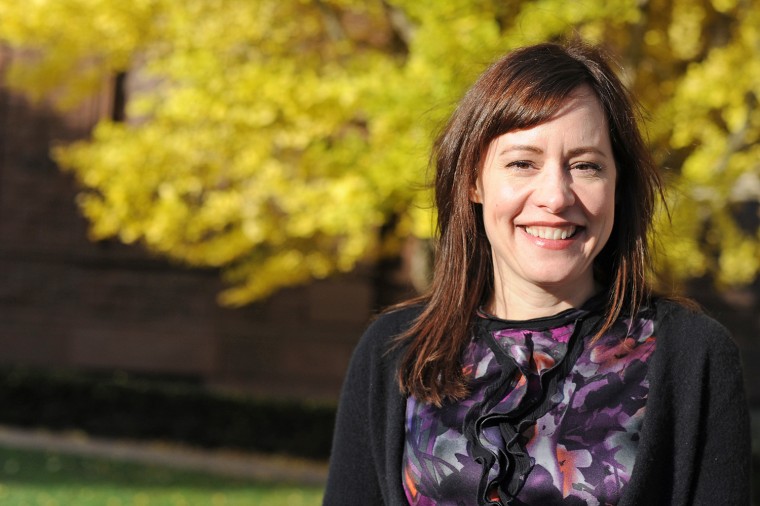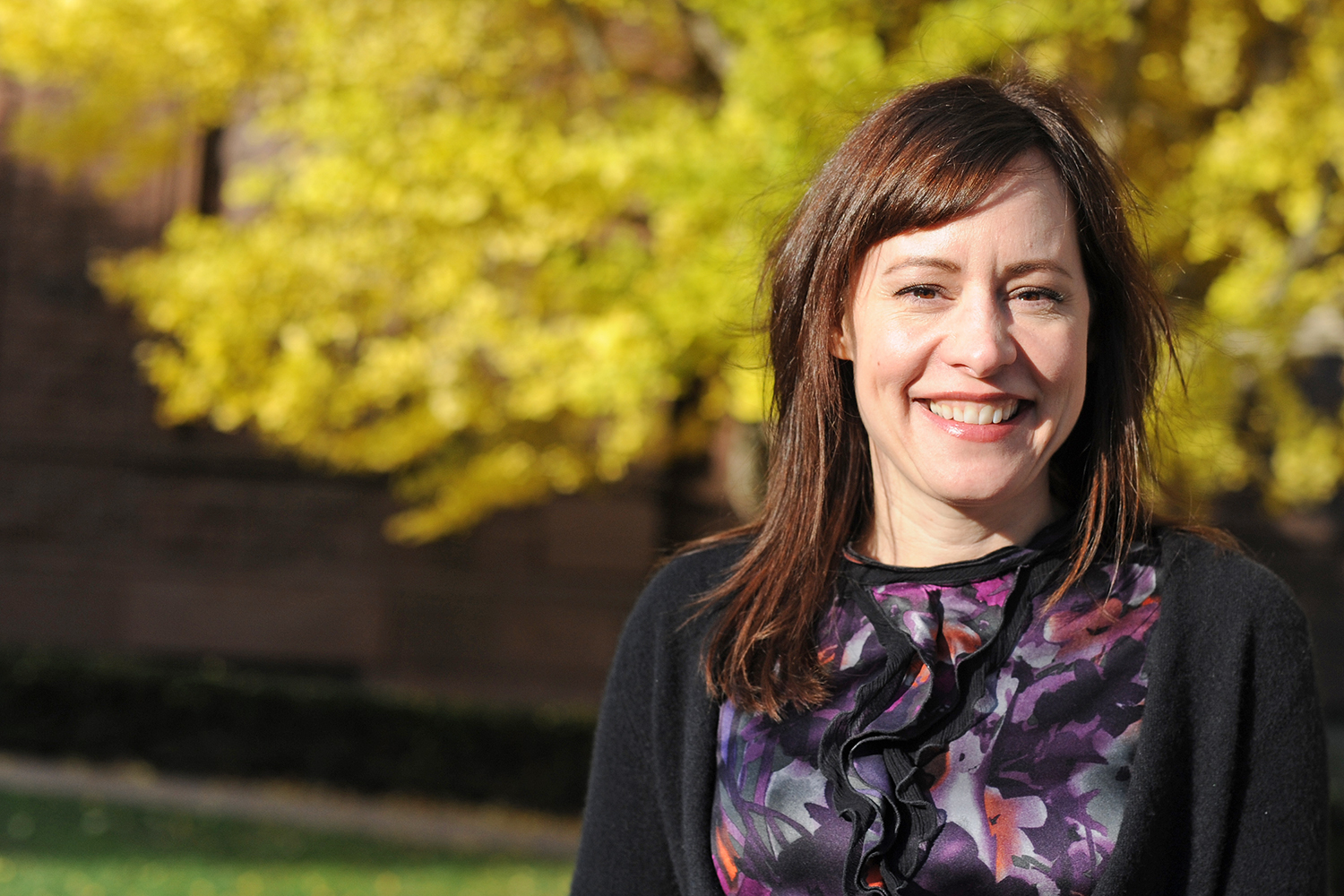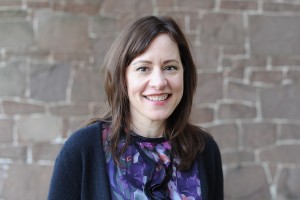FGSS Chair Pitts-Taylor Explores How Bodies are Symbolically, Politically, Socially Meaningful


Victoria Pitts-Taylor, chair and professor of feminist, gender and sexuality studies, joined the faculty this fall.
Q: Welcome to Wesleyan, Professor Pitts-Taylor! What attracted you to Wesleyan?
A: Wesleyan has a great tradition of progressive liberal arts education, including a long tradition of feminist/gender/sexuality studies. Like most programs, it began as women’s studies, more than three decades ago, evolving into its current form as times and perspectives changed. Wesleyan has a reputation for having really smart, socially engaged students, for fostering interest in and commitment to social justice, and for investing in interdisciplinary modes of scholarship and teaching. It’s also full of incredibly accomplished professors, people whom I’d like to read, talk to and learn from.
Q: You came to Wesleyan from the City University of New York. What did your position at CUNY entail?
A: I was at the City University of New York for 15 years – almost my whole academic career since getting my Ph.D. at Brandeis University. I started as an assistant professor in the sociology program at Queens College (part of CUNY) in 1999, and after I received tenure I also began teaching in the doctoral program at the Graduate Center. In 2009, I was promoted to full professor – that was a big deal for me at the age of 36, and I thought back then that I’d probably stay at CUNY forever. But that year, I also became director of the Center for the Study of Women and Society and Coordinator of the Women’s Studies Doctoral Certificate Program at the Graduate Center. I served two terms as head of those programs. I am a sociologist by training and orientation, but over the years I became more deeply involved in gender and sexuality studies. In addition to heading the women’s studies program, I also served as co-editor of the journal Women’s Studies Quarterly (WSQ) for three years. That experience, along with getting involved in the Feminist Press (which publishes WSQ), team-teaching a feminist theory course with a Victorianist, and getting interested in feminist science studies, convinced me that I wanted to be part of a gender studies program.

Q: What has been your impression of the university, and the Feminist, Gender and Sexuality Studies program in particular, so far? How is it different from CUNY?
A: When I walked into my Biofeminisms course, I expected to see a group of juniors and seniors majoring in FGSS. Instead, I got a class filled with biologists, economists and neuroscientists, most of whom had never taken an FGSS class before. Two things strike me about this. First, at most places, the science majors (not to mention the econ majors) wouldn’t often find their way to a gender studies course. Second, these students are very able and willing to learn a new set of concepts and terms, ones that make them cross disciplines, to get a handle on the course. Fortunately, they do not have the usual pre-existing bias that says that feminism and science don’t have a lot to say to each other. I think this says a lot about why I was attracted to Wesleyan in the first place. There are a lot of people here doing research and scholarship, teaching and learning in interdisciplinary areas—not only feminist/gender/sexuality studies, but also science and society, animal studies, disability studies, queer studies and so on. That this interdisciplinary spirit extends to student scientists is remarkable.
Q: What courses are you teaching this year?
A: I already mentioned my Biofeminisms class that I’m teaching this term. Next semester, I’m teaching a new FGSS gateway course, Sex and Gender in Critical Perspective. This class will explore the concepts of “sex,” “gender” and sexuality, and the relations between these. We’ll begin with Simone de Beauvoir’s The Second Sex, move to Gayle Rubin’s famous essays, The Traffic in Women and Thinking Sex, and then take up sex and gender from the early work of Judith Butler onwards. Is sex/gender a system? Is sexuality something separate from sex/gender? What’s the relation between the body and these categories? How do they work in everyday life? How are they historically and culturally specific? What’s their relation to power structures? In what ways are they challenged? We’ll address these questions and many more. The other class I will teach next term is The Sociology of Medicine, Health and Illness. There, we’ll look at the biological body, disease, illness, and identity, and the relations between these. We will take up multiple different ways of looking at health and illness, including different methods, and situate contemporary medicine in its larger social context. For example, we’ll look at the racialization and gendering of certain diagnoses. We’ll address bioethics, too, touching on queer and dis/ability issues.
Q: You’ve written a number of scholarly papers and books about body modification/plastic surgery. Please describe your research in this area.
A: I wrote two books, and edited an encyclopedia, on body practices. In this work I was interested in grasping the ways in which bodies are symbolically, politically, and socially meaningful. I wanted to explore this by starting from the perspective of outliers and extremes – the body artists who offend common sensibilities, or the cosmetic surgery patient who seems to go too far. Even though it may seem on the surface they have little in common (with one group rebelling against norms, and the other striving to achieve them), in fact there are some significant commonalities. They show how the body is a site of semantic instability and contest. The ‘normal’ body is not a constant, but rather a shifting measure against which aesthetics, politics and social values are measured.
Q: And please fill us in on the new book you’re working on, The Brain’s Body: Neuroscience and Corporeal Politics.
A: I have become increasingly interested in science, largely because of the role it plays in defining what bodies are, and what ‘normal’ embodiment is. I started reading neuroscience after I was waylaid by a migraine headache that lasted almost three months. I got fascinated by the idea of what it could mean to explore a body that included the brain, but I quickly found that the body and embodiment meant very different things in different fields. I set to work learning some neuroscience (I read a lot of work on neural plasticity, mirror neurons, and the neurohormone oxytocin, for example, and I did a residential crash course at U Penn’s Center for Neuroscience and Society). If that wasn’t daunting enough, I also realized I had to learn some philosophy, because the subfield, philosophy of mind, is interested in some of the same questions I am interested in. There is very little dialogue between them, but philosophers and feminists both have a lot to say about embodied knowledge, and the body’s role in the mind and subjectivity. As hard as it has been to dive into new fields, I believe we really have to if we want to be part of the big conversations. I wrote “The Neurocultures Manifesto,” which you can find online at the journal Social Text’s website, to argue this.
Q: Your training and research span different disciplines, from sociology to neuroscience. Please describe how this interdisciplinary approach influences your work.
A: Bodies don’t have disciplines. I am fascinated with the body because it can be looked at, experienced, and theorized in so many ways. You live your life in a body that is biological, historical, social, phenomenological, gendered, racialized, nationalized, all at the same time. It exists in evolutionary time, in historical time, and in biographical time. It is represented, or fails to be represented, in popular culture, in the law, in politics. It has its own agency, its own vulnerabilities, and it is shaped by and with the bodies of others. We need different ways of grasping all this complexity.
Q: What direction do you see your research going in the future? Will you involve students in your research, and in what capacity?
A: Well, I just finished The Brain’s Body a few weeks ago, and now I’m turning my attention to an edited volume on feminism and science. After that, I’m not sure, except that it will have bodies in it. I’ve worked with students on many projects in the past, mostly as my research assistants. I’ve been a solo scholar most of the time, but I’d like to learn to do more active collaborations. I recently co-wrote a paper for the first time, with Alexandre Baril, a postdoc who is an FGSS Visiting Scholar this year. It was really exciting – much, much more rewarding than I expected. Other people’s ideas can bring out better ideas in me.
Q: What do you like to do outside of work?
A: I am a travel junkie, although I can’t travel nearly as much as I’d like. Over the summer I went to Japan for the first time, which was amazing. I went by myself, which probably made it even more interesting. I’ve also travelled to Argentina, India, Turkey, South Korea, Australia and all over Europe. But most of the world still beckons.
#THISISWHY

